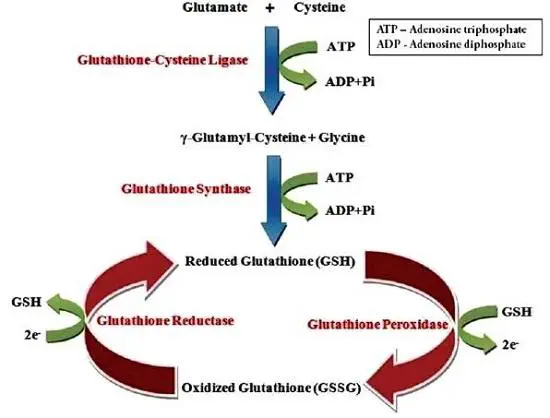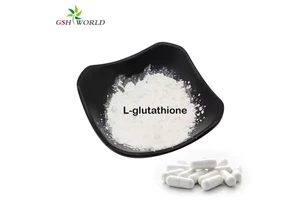The whitening effect of glutathione
What is glutathione?
Glutathione is a low molecular weight thiol tripeptide that plays an important role in maintaining cellular redox balance. In addition to its excellent antioxidant properties, the discovery of its anti melanogenesis properties has also made it a whitening agent. Glutathione exists in reduced form (GSH) and oxidized form (GSSG).
The whitening mechanism of glutathione
Glutathione can reduce tyrosinase activity in three different ways.
Tyrosinase is directly inhibited through thiol chelation of copper sites.
Glutathione interferes with the cellular transfer of tyrosinase to promelanin, which is a prerequisite for melanin synthesis.
The inhibition of tyrosinase is indirectly achieved through its antioxidant activity.
Glutathione transfers melanin production from true melanin to brown melanin synthesis through the reaction between thiol and dopaquinone, leading to the formation of thiol dopaquinone conjugates.
Glutathione has strong antioxidant capacity and has been proven to clear reactive oxygen species produced in epidermal cells induced by ultraviolet radiation.

The application of glutathione
The three main routes of administration of glutathione for whitening are local administration (cream, facial cleanser), oral administration (capsules and sublingual/oral tablets), and intravenous injection.
1. External application of glutathione
A randomized, double-blind, placebo-controlled clinical trial conducted in 30 healthy Filipino women aged 30-50 years provides some evidence, which supports the efficacy of 2% GSSG lotion in temporary whitening. Patients were randomly assigned to take glutathione 2% GSSG lotion and placebo lotion twice a day for 10 weeks.
GSSG is superior to GSH because GSH is unstable in aqueous solution. GSSG ultimately produces GSH after absorption by the skin. Objectively evaluate changes in melanin index, stratum corneum moisture content, skin smoothness, skin elasticity, and wrinkle formation.
Compared with placebo, glutathione significantly reduced melanin index. Glutathione also appears in the form of soaps, facial cleansers and face cream. Recently, chemical exfoliation based on glutathione has also emerged.
Despite the lack of evidence of efficacy, manufacturers claim that it improves melasma, pigmentation, and skin aging.
2. Oral administration of glutathione
A randomized, double-blind, two arm, placebo-controlled study was conducted in Thailand to study the effect of oral glutathione on skin melanin index of 60 healthy medical students.
The subjects were randomly divided into two groups and treated with glutathione capsules at a dose of 500 mg/d or placebo for 4 weeks. In the fourth week, the melanin index of all six parts in the glutathione group continued to decrease. Good tolerance to glutathione.
Another open label study using tablets containing glutathione showed an improvement in skin melanin index measured by a Mexameter. They use tablets instead of capsules to enhance and ensure stable bioavailability. Sublingual or oral routes may be more effective in enhancing the bioavailability of glutathione than oral tablets or capsules.
3. Intravenous injection of glutathione
Due to the low bioavailability of oral glutathione, intravenous injection can produce an "immediate" skin whitening effect.
Manufacturers of intravenous glutathione recommend doses of 600-1200 mg for skin whitening, administered 1-2 times a week. Although intravenous injection of glutathione provides a higher therapeutic dose and enhances its efficacy, its safety range is narrower due to the potential for excessive toxicity.
A placebo-controlled study evaluated the whitening effect of intravenous glutathione in 32 patients. All patients are female, aged 25-47 years old.
Group A consisted of 16 patients who received intravenous injections of glutathione and vitamin C, while Group B received physiological saline as a placebo. Inject 1200mg of GSH (water, 1200mg of glutathione, 35mg of ascorbic acid, hydrolyzed collagen, and sodium chloride).
Inject twice a week for 6 weeks (a total of 12 injections). After 12 injections of glutathione, 6 out of 16 subjects (37.5%) showed significant improvement, while 3 subjects in the placebo group (18.7%) also showed improvement.
After stopping treatment, this improvement gradually disappeared. The serious adverse reactions that require discontinuation of treatment are liver dysfunction and allergic reactions. Glutathione is not very effective in improving skin tone, and its therapeutic effect will disappear over time.
The safety of glutathione
Due to glutathione being a component of human cellular metabolism, the side effects of oral supplements are expected to be mild, similar to high-dose vitamin supplements.
Both the US FDA and the Philippine FDA have issued safety warnings for high-dose injections of glutathione:
Unauthorized injection of high-dose glutathione as a skin whitening agent is unsafe and may harm the patient's physical health, leading to serious consequences. The administration of this ingredient should be limited to 600 mg to 1.2 g per dose, with no more than 2 doses per week.
According to reports, adverse drug reactions caused by the use of glutathione include the following:
Rash, severe and potentially fatal Stevens Johnson syndrome, and toxic epidermal necrolysis; Thyroid dysfunction;
Renal dysfunction, even renal failure. Patients who receive intravenous injections of glutathione twice a week experience severe abdominal pain.










